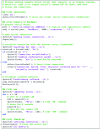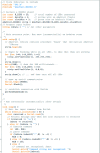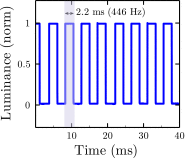Digital LED Pixels: Instructions for use and a characterization of their properties
- PMID: 26487046
- PMCID: PMC5101347
- DOI: 10.3758/s13428-015-0653-5
Digital LED Pixels: Instructions for use and a characterization of their properties
Abstract
This article details how to control light emitting diodes (LEDs) using an ordinary desktop computer. By combining digitally addressable LEDs with an off-the-shelf microcontroller (Arduino), multiple LEDs can be controlled independently and with a high degree of temporal, chromatic, and luminance precision. The proposed solution is safe (can be powered by a 5-V battery), tested (has been used in published research), inexpensive (∼ $60 + $2 per LED), highly interoperable (can be controlled by any type of computer/operating system via a USB or Bluetooth connection), requires no prior knowledge of electrical engineering (components simply require plugging together), and uses widely available components for which established help forums already exist. Matlab code is provided, including a 'minimal working example' of use suitable for use by beginners. Properties of the recommended LEDs are also characterized, including their response time, luminance profile, and color gamut. Based on these, it is shown that the LEDs are highly stable in terms of both luminance and chromaticity, and do not suffer from issues of warm-up, chromatic shift, and slow response times associated with traditional CRT and LCD monitor technology.
Keywords: Arduino; Color gamut; Light emitting diode; Luminance; Timing.
Figures
















Similar articles
-
An inexpensive Arduino-based LED stimulator system for vision research.J Neurosci Methods. 2012 Nov 15;211(2):227-36. doi: 10.1016/j.jneumeth.2012.09.012. Epub 2012 Sep 21. J Neurosci Methods. 2012. PMID: 23000405
-
Evaluation of an organic light-emitting diode display for precise visual stimulation.J Vis. 2013 Jun 11;13(7):6. doi: 10.1167/13.7.6. J Vis. 2013. PMID: 23757510
-
Time-division color electroholography using one-chip RGB LED and synchronizing controller.Opt Express. 2011 Jun 20;19(13):12008-13. doi: 10.1364/OE.19.012008. Opt Express. 2011. PMID: 21716435
-
Light-emitting diodes: whether an efficient source of light for indoor plants?Environ Sci Pollut Res Int. 2017 Nov;24(32):24743-24752. doi: 10.1007/s11356-017-0333-3. Epub 2017 Oct 4. Environ Sci Pollut Res Int. 2017. PMID: 28980183 Review.
-
Interactions between luminance and color signals: effects on shape.J Vis. 2013 Apr 18;13(5):16. doi: 10.1167/13.5.16. J Vis. 2013. PMID: 23599420 Review.
Cited by
-
Perception of Straight Ahead With Vision, Hearing, and Proprioception by Individuals With Low Vision.Invest Ophthalmol Vis Sci. 2025 Jul 1;66(9):38. doi: 10.1167/iovs.66.9.38. Invest Ophthalmol Vis Sci. 2025. PMID: 40657970 Free PMC article.
-
An Open Source Platform for Presenting Dynamic Visual Stimuli.eNeuro. 2021 Jun 11;8(3):ENEURO.0563-20.2021. doi: 10.1523/ENEURO.0563-20.2021. Print 2021 May-Jun. eNeuro. 2021. PMID: 33811085 Free PMC article.
-
Auditory Localisation Biases Increase with Sensory Uncertainty.Sci Rep. 2017 Jan 11;7:40567. doi: 10.1038/srep40567. Sci Rep. 2017. PMID: 28074913 Free PMC article.
References
-
- Maxwell JC. Experiments on Colour, as perceived by the Eye, with Remarks on Colour-Blindness. Transactions of the Royal Society Edinburgh. 1857;21:275–298. doi: 10.1017/S0080456800032117. - DOI
-
- Mach, E. (1959). The analysis of sensations (Translated by CM Williams & S. Waterlow, original work published, 1886).
-
- Tschermak-Seysenegg A. Über parallaktoskopie. Pflüger’s Arch. für die gesamte Physiol. des Menschen und der Tiere. 1939;241:455–469. doi: 10.1007/BF01755547. - DOI
-
- Howard, I.P. (2012). Perceiving in depth, volume 1: basic mechanisms: Oxford University Press.
MeSH terms
LinkOut - more resources
Full Text Sources
Other Literature Sources
Research Materials

